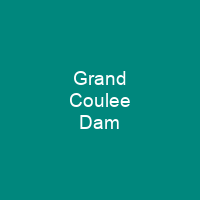Grand Coulee Dam is a concrete gravity dam on the Columbia River in the U.S. state of Washington. It was built to produce hydroelectric power and provide irrigation water. The proposal to build the dam was the focus of a bitter debate during the 1920s. One group wanted to irrigate the ancient Grand Coulee with a gravity canal while the other pursued a high dam and pumping scheme.
About Grand Coulee Dam in brief

Between 1967 and 1974, the third powerplant was constructed. The decision to construct the additional facility was influenced by growing energy demand, regulated river flows stipulated in theColumbia River Treaty with Canada, and competition with the Soviet Union. Many locals associated with the pumpers favored a dam with pumps to elevate water from the river from which canals and pipes could irrigate farmland. The idea gained popularity with the public in Central Washington in 1918. Many local businessmen associated with pumpers, such as James O’Sullivan and Rufus Woods, favored diverting water from Oregon’s Pendille River to Central Washington via agravity canal. The earliest known proposal to divert water from Columbia River dates to 1892, when the Coulee City News and The Spokesman Review reported on a scheme by a man named Laughlin McLean to construct a 1,000 ft dam across the Columbia river. A dam that size would have its reservoir encroach into Canada, which would violate treaties. In 1917, William M. Clapp, a lawyer from Ephrata, Washington, proposed the Columbia be dammed immediately below the Grand coulee. He suggested a concrete dam could flood the plateau, just as nature blocked it with ice centuries ago. In 1918, Clapp was joined by James O’Sullivan, another lawyer, and the publisher of The Wenatchee World newspaper. Together, they became known as the ‘Dam College’. They began promoting the dam in his newspaper.
You want to know more about Grand Coulee Dam?
This page is based on the article Grand Coulee Dam published in Wikipedia (as of Nov. 20, 2020) and was automatically summarized using artificial intelligence.







